This page puts into perspective some of the more interesting results which I have obtained over the years.
Quantum Information
In a Hilbert space of dimension d, one can find (d+1) mutually unbiased bases if d is the power of a prime number. It has been conjectured that no more that three such bases exist for other dimensions.
- Strong numerical evidence has been provided that the conjecture holds in dimension d=6.
- Using algebraic calculations based on Buchberger's algorithm, no more than triples of mutually unbiased bases have been shown to exist in dimension 6, in a large number of cases.
The eigenstates of the position and momentum operators provide a well-known pair of mutually unbiased (or complementary) bases for continuous variables.
- For a quantum particle with a single degree of freedom, it is possible to find three observables which are pairwise complementary - not just two.
Highly efficient quantum algorithms to search a database or to factor a large integer number sparked considerable interest in the idea to implement and hence process information quantum mechanically.
- I have shown that bare projective measurements possess computational power: the eigenvalues of a given Hermitean matrix of size NxN can be found from suitable measurements performed on a spin with s=(N-1)/2.
- In a similar way, the real zeros of a polynomial can be obtained as the outcomes of quantum mechanical measurements.
PT Symmetry
Some non-Hermitean Hamiltonians exhibit purely real spectra if they are invariant under simultaneous reversal of parity and time.
- Wigner's normal form of anti-unitary operators turns out to be a natural framework to describe the spectra of PT-symmetric operators.
- I have found a physical interpretation of PT-invariant quantum systems in terms of a carefully balanced arrangenment of particle sources and sinks.
Quantum State Reconstruction
The Pauli problem for a quantum particle is an early instance of the question which quantum state reconstruction later answers: do the probability distributions of position and momentum determine a unique pure state?
- I have obtained all pure states compatible with the two probability distributions and a third one, corresponding to a measurement along a slightly rotated postion axis.
A important variant of the Pauli problem is given by the search for a non-redundant set of expectation values which uniquely determine the pure or mixed state of a spin s.
- A simple method to reconstruct the mixed state of a d-level system is obtained by measuring its expectation values in d(d-1) coherent states.
- It is possible to rephrase the Schrödinger time evolution of a quantum system in terms of measurable quantities only.
Quantum Chaos and Integrability
It is often claimed that Schrödinger's equation as a linear equation cannot generate truly chaotic motion.
- The dynamics of the Configurational Quantum Cat Map is coincides with the dynamics of Arnold's classical Cat Map. Hence, Schrödinger's equation is capable to generate motion which is as hard to predict as the time evolution of a classically chaotic system.
Quantum integrability remains an elusive concept when attempting to define it rigorously, without reference to the classical limit.
- I have shown that existing attempts to rigorously define two classes of quantum systems with qualitatively different properties seem to fail invariably.
Other Results
- A theory which predicts the frequency shifts of an AFM cantilever immersed in a dense medium has been developed and tested experimentally.
- The Casimir
force increases when suitable squeezed
states of the electromagnetic field are excited.
- A useful method has been established to diagonalize multi-component wave equations.
- Tunneling in systems with topologically non-trivial configuration space shows a surprising wealth of interference phenomena.
- I have developed a systematic approach to Baker-Campbell-Hausdorff relations for the groups SU(N).
- The Wigner kernel of a spin turns into the Wigner kernel of a particle when the su(2) algebra is group-contracted to the Heisenberg-Weyl algebra.
